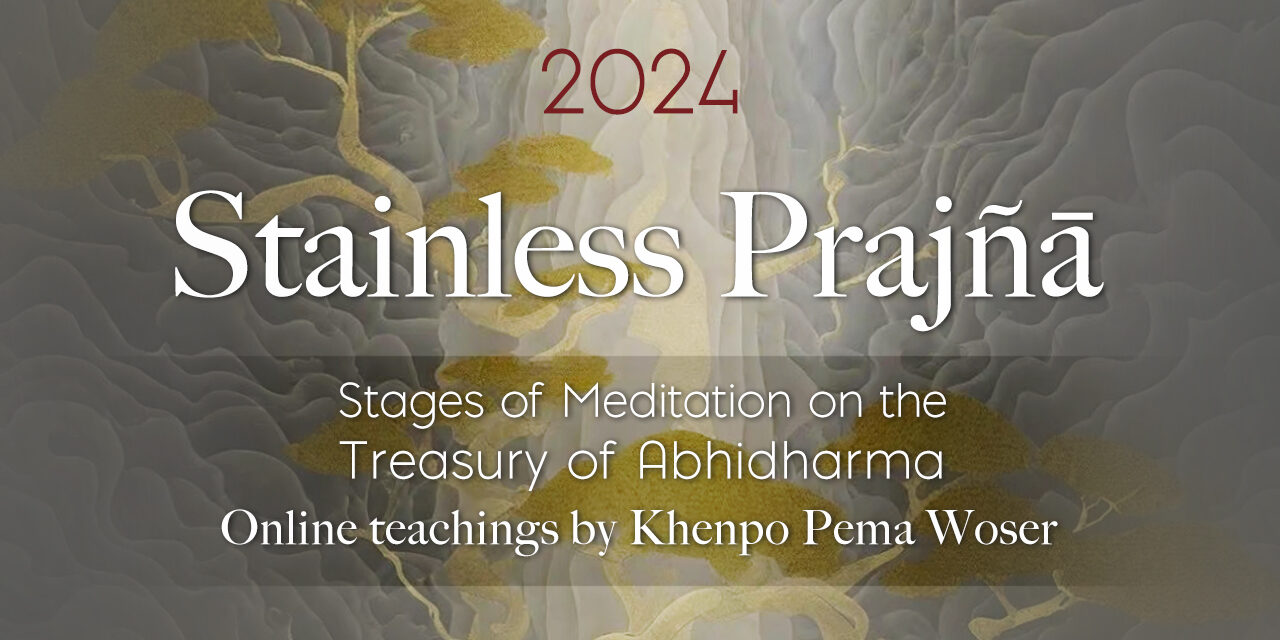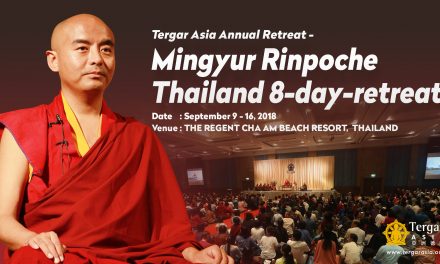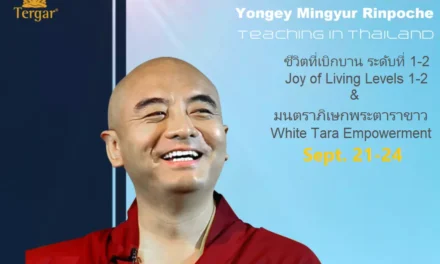The essence of Abhidharma teachings is to explore the nature of reality of all phenomena, and to bring that wisdom into our experience and practice. As a result of that, we will gain liberation and enlightenment.
This is what Mingyur Rinpoche taught us in the “Essence of Abhidharma” teachings.
Starting from 2024, Tergar Asia will launch a new teaching program on Abhidharma. Khenpo Pema Woser will teach based on the book composed by Mingyur Rinpoche, “Stainless Prajñā – Stages of Meditation on the Treasury of Abhidharma”. Khenpo will guide us to discover the nature of reality in stages. He will also teach us how to apply the wisdom in meditation practice and daily experience.
- The necessity of learning Abhidharma
Buddha’s teachings are included in both of scripture and realization. We uphold the teachings of scripture through discourse and the teachings of realization through practice. If we don’t practice, truth of the path will not arise. If truth of the path is not arisen, we are unable to abandon karma and afflictive emotions. Without abandoning them, liberation is not obtained. In terms of practice, we first need to know the way of practice. Therefore, in the stages of practice in Abhidharma, the explanations are concise but easy to understand. In terms of meaning, the Stages of Meditation on Abhidharma is consistent with the Buddha’s words and the commentaries composed by the panditas who follow the Buddha. Therefore, it’s necessary to learn the stages of meditation on the treasury of Abhidharma.
- The benefits of knowing Abhidharma
The stages of meditation on the treasury of Abhidharma contain stages of meditation of both shamatha and vipashyana.If we understand the stages of shamatha meditation, based on that, we know how to live a life with a happy and open mind. Ultimately, it becomes the support for the arising of vipashyana. We are able to know how to abandon those afflictions that make us unpeaceful.If we know how to practice vipashyana, then based on that, we will know the nature of reality – impermanence, suffering, emptiness, selflessness. We will be free from the clinging to the cleanliness, happiness, permanence, and self, thus swiftly obtaining Stainless Prajñā.
- How Abhidharma is related to JOL teachings
In general, the four philosophical schools (Vaibhashika, Sautrantika, Cittamatra, Madhyamaka) are not different in terms of superiority of the view. But rather, they are like the steps of a staircase to enter the dharma. Therefore, the presentation of the ground, path and fruition taught in the Treasury of Abhidharma or the Vaibhashika is a wonderful entry into the dharma, for beginning practitioners for example. Especially, if we practice stages of meditation taught in Joy of Living –awareness, loving-kindness compassion and the view of self-lessness and etc., together with the shamatha and vipashyana practices taught in Abhidharma, the experience and realization will enhance swiftly. It is just like adding fire to the sunshine, adding rain to the river. Stages of practice taught in the foundational philosophical schools can also be understood in a more profound, vast, and easy way in the view, meditation and conduct taught in the higher philosophical schools. These are the benefits and connection to JOL teachings.
The program will last two to three years. In year 2024, Khenpo will cover introduction of Abhidharma, stages of the path and shamatha meditation. In year 2025, Khenpo will pick up from where we leave off in 2024 and start the teaching of vipashyana meditation.
Dates (2024)
April 10th, 24th
May 8st, 22nd
June 5th, 19th
July 3rd, 17th
August 7th, 21st
September 4th, 18th
October 2nd, 16th
November 6th, 20th
December 4th, 18th
* Teaching dates for year 2025 will be announced in the future.
Time
8:30 – 10:00pm (Beijing, Hongkong, Taiwan, Malaysia time)
7:30 – 9:00pm (Thailand, Indonesia time)
6:15 – 7:45pm (Nepal time)
Language
Khenpo will teach in Tibetan. Translation will be available in English, Mandarin, Cantonese, Korean, Indonesian, Thai, Japanese and Vietnamese.
Registration
Registration is closed.
This program is open to everyone, free of charge.
About Khenpo Pema Woser
Khenpo Pema Woser was born near the border between Tibet and Nepal in a region known as Tsum. After the tragic death of his mother, Khenpo-la left his home in order to study and practice the Dharma and joined Tergar Oseling Monastery, locarted near the great stupa of Swayambunath. Shortly after, and at the encouragement of Mingyur Rinpoche, his root guru, Khenpo Pema Woser joined the monastic college at Sherab Ling monastery. Since completing his traditional monastic studies and receiving the title of Khenpo in 2010, Khenpo Pema Woser has worked closely with Mingyur Rinpoche to realize his vision at Tergar Osel Ling, primarily teaching logic, debate, and epistemology, and serving in various leadership roles.
In addition to the traditional course of study, Khenpo-la has studied many important practice systems. He had the great fortune to discuss scriptures with His Holiness the 17th Gyalwang Karmapa for one month. He received transmission, empowerment, and teachings on the Great Five Treasuries by Jamgon Kongtrul Lodro Thaye as well as numerous commentaries on Mahamudra from Guru Vajradhara His Holiness Chamhon Kenting Tai Situ Rinpoche; teachings on stages of practices on Abhidharma and Mahamudra from H.E. Yongey Mingyur Rinpoche; teachings on “Words of My Perfect Teachers”, “Uttaratantra”, “Jewel Ornament of Liberation” from H.E. Sangye Nyenpa Rinpoche, and many more.




